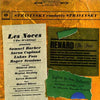





Stravinsky conducts Stravinsky - Les Noces, Renard, Ragtime for Eleven Instruments
Igor Stravinsky - Les Noces (The Wedding)
Pianists : Samuel Barber, Aaron Copland, Lukas Foss, Roger Sessions
Mildred Allen (soprano), Regina Sarfaty (mezzo-soprano), Loren Driscoll (tenor), Robert Oliver (bass)
The Columbia Percussion Ensemble and Tha American Concert Choir
Conducted by Igor Stravinsky
Igor Stravinsky - Renard (The Fox)
George Shirley (tenor), Loren Driacon (tenor), William Murphy (baritone), Donald Gramm (bass)
The Columbia Chamber Ensemble conducted by Igor Stravinsky
Igor Stravinsky - Ragtime for Eleven Instruments
The Columbia Chamber Ensemble conducted by Igor Stravinsky
1 LP, standard sleeve
Original analog Master tape : YES
Heavy Press : 180g
Record color : black
Speed : 33 RPM
Size : 12'’
Stereo
Studio
Record Press : Pallas
Label : Speakers Corner
Original Label : Columbia
Recording: September 1962 at American Legion Hall, Hollywood, and January 1962 at Manhatten Center, New York, by Edwin Michalski
Production: John McClure
Originally released in 1962
Reissued in 2016
Tracks :
Side A : Les Noces (“The Wedding”)
Side B :
- Renard (“The Fox”)
- Ragtime For Eleven Instruments
Reviews :
“The 20th Century era of classical music was notable for its divergent styles. Without a predominant sub-genre, composers engaged in romantic, neo-classicism, modernism, jazz-influenced, impressionism, minimalism and free dissonance. It is widely believed that the most influential and diverse composer of this exciting and at times unpredictable time period was Igor Stravinsky. Starting as a student of Rimsky-Korsakov, he redefined rhythmic structures and musical arrangement. His embrace of religious orthodoxy and creative freedom was a unique and potent combination. While Stravinsky would garner renown for a variety of classical writing, he rose to prominence for three ballet scores, The Firebird, Petrushka and The Rite Of Spring.
Speakers Corner Records has released a 180-gram vinyl of a 1962 Columbia Masterworks album, Stravinsky Conducts Stravinsky. It consists of three very different performances, ‘Les Noces/The Wedding”, “Renard/The Fox” and “Ragtime For Eleven Instruments”. Side 1 opens with a performance of “Les Noces (The Wedding)”. This is a ballet and orchestral concert piece. The stripped down arrangements features an exceptional ensemble of four pianist, each one a defining figure in 20th century music in their own right: Aaron Copland; RogerSessions, Lukas Foss and Samuel Barber—the pitched percussion. The un-pitched percussion is performed by the Columbia Percussion Ensemble. The arrangement reflects the composer’s vision for original score. Characters are voiced abstractly as Stravinsky described in the liner notes. He utilizes soprano (Mildred Allen), mezzo-soprano (Regina Saarfaty), tenor (George Shirley) and baritone (Donald Graham). Here. the master himself conducts the recording session. All of the elements of Stravinsky are present…religious dedication, family, tradition and dramatic angst. The piano/percussion-centric arrangement is filled with military-like precision and staccato accents. The listener can appreciate the influence Stravinsky would have on contemporary modern composers. Complex ideas and emotions are channeled through the nervous bride (exchanging with her bridesmaids and mother) and the bridegroom’s dialogue with his father. Some of the music takes on a stark, uneasy resonance (with occasional dissonance), but there is a whimsical balance in some of the chorus refrains. Additionally, the bride (soprano) and tenor (bridegroom) share a beautiful counterpoint. Stravinsky has indicated that the vocal parts are non-specific. What makes “Les Noces/The Wedding” compelling is the relentless commitment to intensity and a smaller orchestral imprint. While it wasn’t universally praised at its debut, it has become a shining example of the Stravinsky musical genius.
Side 2 offers two compositions which diverge musically. There is fuller orchestration. First up is “Renard (The Fox)”, Stravinsky’s allegorical tale of barnyard treachery and mayhem. Horns and percussion usher in this lively performance. Compelling sudden time-signature changes and arpeggios explode, followed by lyrical interludes translated by different woodwinds. After the 13:00 mark, the cimbalom (similar to a hammer dulcimer) is introduced which adds a folkish resonance. Of course there are march-time tempos (another nod to military-precision) that capture the dramatic evolution of the mortal struggles of animals. The voices and instruments bring the almost cartoon-like creatures (preening rooster, sly, malevolent fox) to life. Stravinsky’s piety and moral compass is on display as Renard meets his inevitable demise. There are several humorous moments, including the ending. The libretto has been translated into English at the request of the composer. A second number, “Ragtime For Eleven Instruments” features a classical re-imagination of ragtime jazz with flute, clarinet, horns, cimbalom, trombone violas and a double bass. Stravinsky and the Columbia Chamber Ensemble distill the jazzy nuances and riveting moments of syncopation in a mere 4:36. The swaying melodic structures feel like a precursor to some of the choreographed segments in “West Side Story”. It is memorable.
Speakers Corner has done an outstanding job on this 180-gram re-master. The vital percussion is rendered with distinct crispness in the mix. The operatic voices are centered and integrate like instruments. This vinyl pressing is flawless with little surface noise, and no hisses or pops.” Robbie Gerson, Audiophile Audition, May 2021
Although ten years separate the gigantic composition "Le Sacre du Printemps" and the dance cantata "Les Noces", the more recent work has several things in common with its scandalous predecessor. Originally Stravinsky planned to use a vast orchestra of 150 musicians, but decided after numerous attempts to settle for four pianos, percussion, voices and mixed chorus. Concealed behind the innocuous title is not a peasant wedding but once again an archaic ritual, »which takes possession of several of the central figures, drives them on and eventually crushes them with its unrelenting movement« (André Boucourechliev, Igor Stravinski, Fayard 1982). Ballet, rhythmic dance through and through, fuses with Russian melodic song and thereby exudes a folkloristic exoticism.
Rarely performed yet zestful and a sheer delight for the ears is the burlesque tale "Renard", a musical fable about Reynard the crafty Fox, the Cock, the Cat, and the Ram.
Stravinsky himself conducted this recording made with a grand line-up of America’s top composers at the piano keyboard – Samuel Barber, Lukas Foss, Aaron Copland and Roger Sessions. One certainly can’t ask for more authenticity on record than these contemporary witnesses.
Ratings :
Discogs : Rate Your Music :


